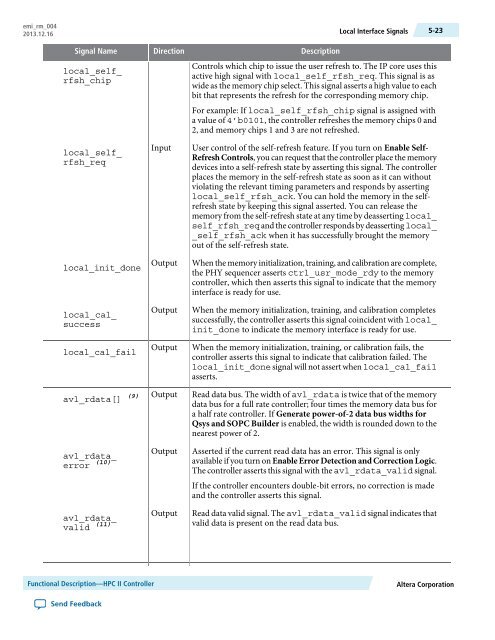Functional Description -- HPC II Controller, External Memory ... - Altera
Functional Description -- HPC II Controller, External Memory ... - Altera
Functional Description -- HPC II Controller, External Memory ... - Altera
Create successful ePaper yourself
Turn your PDF publications into a flip-book with our unique Google optimized e-Paper software.
emi_rm_004<br />
2013.12.16<br />
Local Interface Signals<br />
5-23<br />
Signal Name<br />
local_self_<br />
rfsh_chip<br />
local_self_<br />
rfsh_req<br />
local_init_done<br />
local_cal_<br />
success<br />
local_cal_fail<br />
avl_rdata[] (9)<br />
avl_rdata_<br />
error (10)<br />
avl_rdata_<br />
valid (11)<br />
Direction<br />
Input<br />
Output<br />
Output<br />
Output<br />
Output<br />
Output<br />
Output<br />
<strong>Description</strong><br />
Controls which chip to issue the user refresh to. The IP core uses this<br />
active high signal with local_self_rfsh_req. This signal is as<br />
wide as the memory chip select. This signal asserts a high value to each<br />
bit that represents the refresh for the corresponding memory chip.<br />
For example: If local_self_rfsh_chip signal is assigned with<br />
a value of 4’b0101, the controller refreshes the memory chips 0 and<br />
2, and memory chips 1 and 3 are not refreshed.<br />
User control of the self-refresh feature. If you turn on Enable Self-<br />
Refresh Controls, you can request that the controller place the memory<br />
devices into a self-refresh state by asserting this signal. The controller<br />
places the memory in the self-refresh state as soon as it can without<br />
violating the relevant timing parameters and responds by asserting<br />
local_self_rfsh_ack. You can hold the memory in the selfrefresh<br />
state by keeping this signal asserted. You can release the<br />
memory from the self-refresh state at any time by deasserting local_<br />
self_rfsh_req and the controller responds by deasserting local_<br />
_self_rfsh_ack when it has successfully brought the memory<br />
out of the self-refresh state.<br />
When the memory initialization, training, and calibration are complete,<br />
the PHY sequencer asserts ctrl_usr_mode_rdy to the memory<br />
controller, which then asserts this signal to indicate that the memory<br />
interface is ready for use.<br />
When the memory initialization, training, and calibration completes<br />
successfully, the controller asserts this signal coincident with local_<br />
init_done to indicate the memory interface is ready for use.<br />
When the memory initialization, training, or calibration fails, the<br />
controller asserts this signal to indicate that calibration failed. The<br />
local_init_done signal will not assert when local_cal_fail<br />
asserts.<br />
Read data bus. The width of avl_rdata is twice that of the memory<br />
data bus for a full rate controller; four times the memory data bus for<br />
a half rate controller. If Generate power-of-2 data bus widths for<br />
Qsys and SOPC Builder is enabled, the width is rounded down to the<br />
nearest power of 2.<br />
Asserted if the current read data has an error. This signal is only<br />
available if you turn on Enable Error Detection and Correction Logic.<br />
The controller asserts this signal with the avl_rdata_valid signal.<br />
If the controller encounters double-bit errors, no correction is made<br />
and the controller asserts this signal.<br />
Read data valid signal. The avl_rdata_valid signal indicates that<br />
valid data is present on the read data bus.<br />
<strong>Functional</strong> <strong>Description</strong>—<strong>HPC</strong> <strong>II</strong> <strong>Controller</strong><br />
<strong>Altera</strong> Corporation<br />
Send Feedback
















